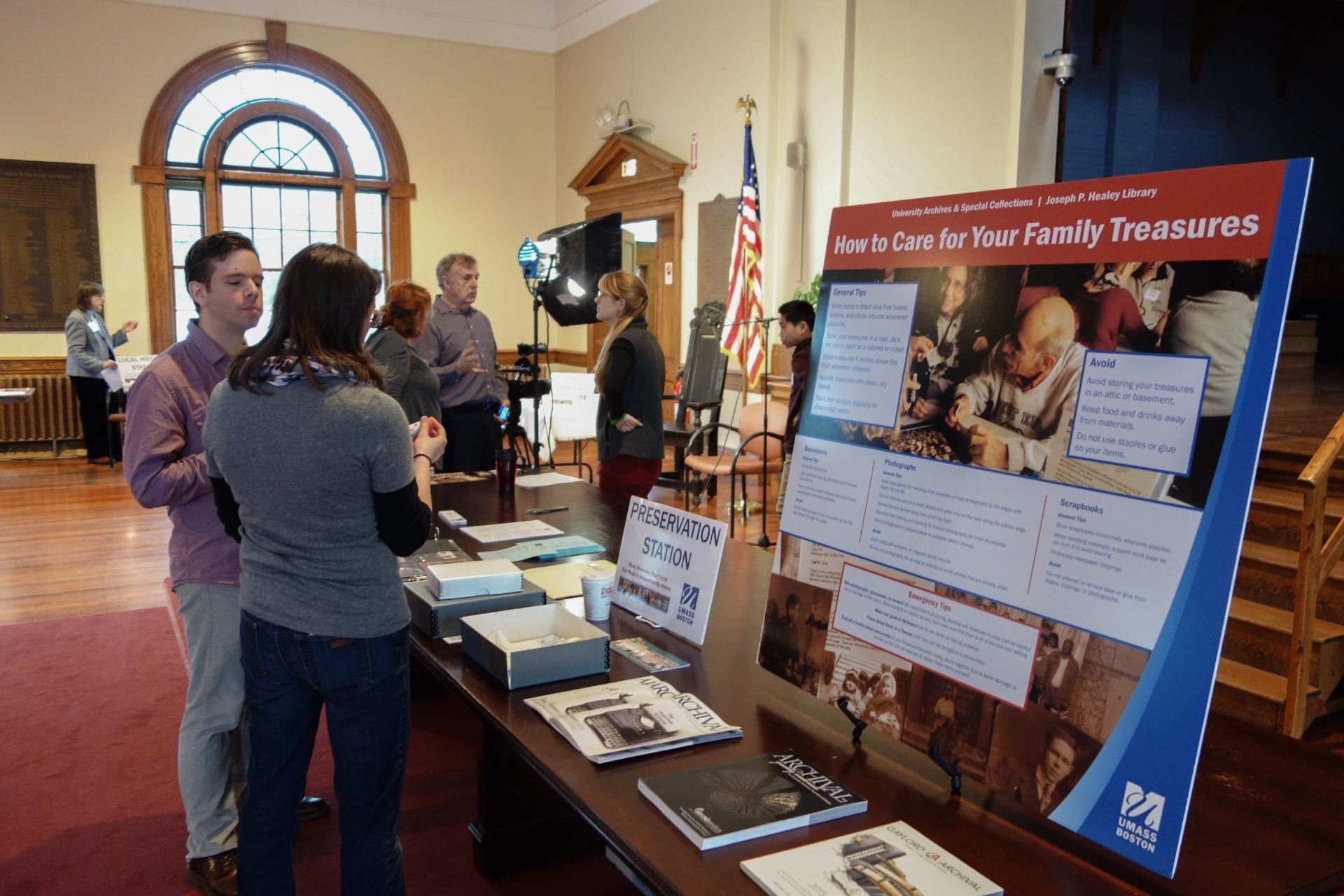 About this station
About this station
At the Preservation Station, contributors are invited to ask a professional archivist how to care for and preserve their family photographs and documents. For the Mass. Memories Road Show program, we often partner with a professional organization that can help provide this service, such as the Northeast Document Conservation Center (NEDCC) or the New England Archivists (NEA). Contributors will be invited to ask questions and learn about how to preserve a wide array of materials, from papers to photographs, audiovisual media, and even digital files. Your primary responsibility as a volunteer at the Preservation Station is to support the professional archivist in navigating these questions and educating contributors. To do this, you will need to learn about a contriubutor’s family materials and help them identify achievable next steps. Engaging contributors patiently in this way requires time and focus, which is why your support is essential to this Station’s success.
With this in mind, the goals for the Assistant at the Preservation Station are as follows:
- Invite contributors to visit the Preservation Station
- Explain the purpose of preservation
- Learn about contributors’ collections
- Recommend tips and strategies for preserving contributors’ collections, in consultation with the professional archivist
 Supplies
Supplies

Supplies needed at the Preservation Station:
- One 6-8’ table and 2 chairs for staff
- Instructional sign and tabletop easel Pictured below.
- Caring for Private and Family Collections leaflet, published by the Northeast Document Conservation Center (NEDCC) This will give you an understanding of approachable solutions to the most common problems you will be asked about (https://www.nedcc.org/assets/media/images/Pres_Fam_Collections_2013.pdf).
- Catalogs for a reputable archival supplies vendors A few examples are included below:
- The pamphlet Save As: Basic rules for digital preservation. This pamphlet offers very practical solutions for this complicated topic (http://bewaarals.nl/wp-content/uploads/2017/05/2011_1005_Save_As_digi_ENG.pdf).
- Sample acid-free boxes and folders Navigating archival products can be difficult for people who are new to collections care, so pointing to specific products can be helpful. Folders and boxes are popular enclosures can be purchased from the vendors listed above.
- Sample scrapbook Many scrapbooks available in craft supply stores are not safe for documents and photographs. Beware of scrapbooks branded as “archival” or “acid free.” These are not regulated terms. Archival scrapbooks for original documents and photographs can be purchased from archival suppliers, along with photo corners.
- Sample photo album The Mass. Memories Road Show uses a Pioneer E-Z Load 12”x12” Memory Book, which is acid, lignin, and PVC free. Avoid books and albums with magnetic pages and adhesives. Archival albums for original documents and photographs can be purchased from archival suppliers, along with photo corners.

 How it works
How it works
Let’s take a closer look at how the Preservation Station works!

Section 1 of 3: Explain the purpose of preservation
As the Assistant, it is important to advocate for preservation and introduce key preservation concepts. Some contributors may be unsure of what the purpose of your station is and of what can be done to slow down the deterioration of their family treasures.
Section 2 of 3: Learn about contributors’ collections
Once the contributor understands the nature and purpose of preservation, they may have questions about their own collections. If they do not, encourage them to talk about their collections. Ask what kinds of treasures they have. Perhaps they have paper documents, old photographs, digital files, or audio recordings. By asking about their collections, the contributor may think of a treasure that is especially important to them and ask what they might do to preserve it. While a contributor may not initially have any questions or know what to ask, you can ask your own questions to kindle their curiosity.
Section 3 of 3: Recommend strategies and solutions
Once you have engaged a contributor and explained what the Preservation Station is about, they are likely to ask you for advice on how they might better preserve their own treasures. At this point, it is best to focus on solutions that contributors will actually pursue. Keep it simple! It is better to recommend a workable solution that the contributor will definitely pursue than a professional solution that they won’t pursue.
Tips
Handle collections as little as possible. Simply having the item flat on the table and gently opening a page or two if the item is a bound volume should be enough for you to give collections care advice. Don’t try to take photographs out of frames or albums without consulting with the professional archivist.
Don’t be afraid to say you don’t know. Questions can be unpredictable. You can always refer contributors to a resource online, such as Northeast Document Conservation Center’s (NEDCC) Leaflets about the preservation of paper, books, photographs, AV, and digital files (https://www.nedcc.org/free-resources/preservation-leaflets/overview) or the American Institute for Conservation’s (AIC) Caring for Your Treasures for the above formats, as well as textiles, art, and objects (https://learning.culturalheritage.org/caring-treasures).
Focus on simple solutions. It is best to focus on storage location, environment, enclosures, and strategies for storing the item in a way that doesn’t lead to it getting crushed or warped. The simpler your guidance is, the more likely your contributor will be to do it when they get home.
Common contributor questions
Is there a fee to have the archivist look at my photos?
No. The entire event is free and open to the public.
 Congratulations!
Congratulations!
You’ve completed the Preservation Station module. Click here to start the Local History Station module, or return to the full list of instructional modules.
